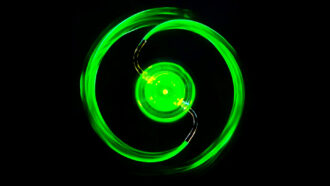astronomer: A scientist who works in the field of research that deals with celestial objects, space and the physical universe.
cell: The smallest structural and functional unit of an organism. Typically too small to see with the unaided eye, it consists of a watery fluid surrounded by a membrane or wall. Depending on their size, animals are made of anywhere from thousands to trillions of cells. Most organisms, such as yeasts, molds, bacteria and some algae, are composed of only one cell.
constant: Continuous or uninterrupted. (in mathematics) A number that is known and unchanging, usually based on some mathematical definition. For example, π (pi) is a constant equal to 3.14. . . and defined as the circumference of a circle divided by its diameter.
data: Facts and/or statistics collected together for analysis but not necessarily organized in a way that gives them meaning. For digital information (the type stored by computers), those data typically are numbers stored in a binary code, portrayed as strings of zeros and ones.
electricity: A flow of charge, usually from the movement of negatively charged particles, called electrons.
electromagnetic: An adjective referring to light radiation, to magnetism or to both.
electromagnetic radiation: Energy that travels as a wave, including forms of light. Electromagnetic radiation is typically classified by its wavelength. The spectrum of electromagnetic radiation ranges from radio waves to gamma rays. It also includes microwaves and visible light.
gamma rays: High-energy radiation often generated by processes in and around exploding stars. Gamma rays are the most energetic form of light.
infrared: A type of electromagnetic radiation invisible to the human eye. The name incorporates a Latin term and means “below red.” Infrared light has wavelengths longer than those visible to humans. Other invisible wavelengths include X-rays, radio waves and microwaves. Infrared light tends to record the heat signature of an object or environment.
laser: A device that generates an intense beam of coherent light of a single color. Lasers are used in drilling and cutting, alignment and guidance, in data storage and in surgery.
matter: Something that occupies space and has mass. Anything on Earth with matter will have a property described as "weight."
radiant: (adj.) A term for something that is radiated, such as heat or some other type of radiation. (n.) The point or object from which light or heat radiates (such as the heating element in an electric heater). Or the point from which objects (such as meteors) appear to come.
radiation: (in physics) One of the three major ways that energy is transferred. (The other two are conduction and convection.) In radiation, electromagnetic waves carry energy from one place to another. Unlike conduction and convection, which need material to help transfer the energy, radiation can transfer energy across empty space.
radio: Referring to radio waves, or the device that receives these transmissions. Radio waves are a part of the electromagnetic spectrum that people often use for long-distance communication. Longer than the waves of visible light, radio waves are used to transmit radio and television signals. They also are used in radar. Many astronomical objects also radiate some of their energy as radio waves.
radio waves: Waves in a part of the electromagnetic spectrum. They are a type that people now use for long-distance communication. Longer than the waves of visible light, radio waves are used to transmit radio and television signals. They also are used in radar.
rainbow: An arc of color displayed across the sky during or just after a rain. It’s caused when water droplets in the atmosphere bend (or diffract) white sunlight into a number of its component hues: usually red, orange, yellow, green, blue, indigo and violet.
refraction: The change in direction of light (or any other wave) as it passes through some material. For example, the path of light leaving water and entering air will bend, making partially submerged objects to appear to bend at the water’s surface.
ultraviolet: A portion of the light spectrum that is close to violet but invisible to the human eye.
ultraviolet light: A type of electromagnetic radiation with a wavelength from 10 nanometers to 380 nanometers. The wavelengths are shorter than that of visible light but longer than X-rays.
universe: The entire cosmos: All things that exist throughout space and time. It has been expanding since its formation during an event known as the Big Bang, some 13.8 billion years ago (give or take a few hundred million years).
vacuum: Space with little or no matter in it. Laboratories or manufacturing plants may use vacuum equipment to pump out air, creating an area known as a vacuum chamber.
wave: A disturbance or variation that travels through space and matter in a regular, oscillating fashion.
wavelength: The distance between one peak and the next in a series of waves, or the distance between one trough and the next. It’s also one of the “yardsticks” used to measure radiation. Visible light — which, like all electromagnetic radiation, travels in waves — includes wavelengths between about 380 nanometers (violet) and about 740 nanometers (red). Radiation with wavelengths shorter than visible light includes gamma rays, X-rays and ultraviolet light. Longer-wavelength radiation includes infrared light, microwaves and radio waves.
X-ray: A type of radiation analogous to gamma rays, but having somewhat lower energy.









